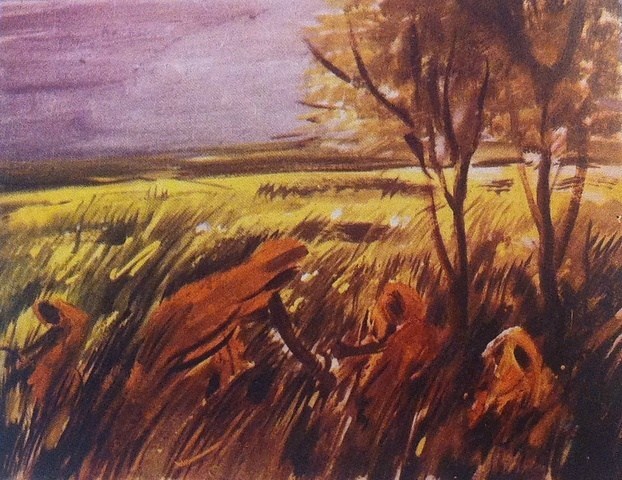There are nine artists considered to be National Art Treasures - The three Tagores (Abanindranath, Gananendranath, Rabindranath), Ram Kinker Baij, Jamini Roy, Nicholas Roerich, Nandalal Bose, Amrita Sher-Gil and lastly Sailoz Mukherjee.
The one that I
Sailoz died in 1961 - the Greek tragedy: He had an auto-rickshaw accident and instead of getting professional help, he was given a "
Two clear and major periods can be identified in his paintings (mostly in the 1950s):
a) Landscapes (often "moving/fluid" landscape and possibly with a building) with small figures on one corner (influence of

b) Figures with "scratching" - an example would be the recent reclining lady at an Indian Auction house -
Canvases
The views of some artists and critics are worth a read.
"There should have been a monument dedicated to Sailoz in the middle of Connaught Place instead of an ugly fountain. There is not a single work of Amrita Sher-Gil which can stand before his painting Washing Day. The reason he has not gotten the recognition is that he lacks in pretentiousness" - Jagdish Swaminathan
"For after Amrita Sher-Gil...he has been our most significant painter" - Richard Bartholomew
There is a reason for this strong statement above. At a time when the Santiniketan masters were focusing on their form of Oriental art (Indian miniatures, washes on paper,
As a reference, during this time the progressives had just started their careers and most of their works at that time were inspired by the Western modern art of a few decades ago.
Of late, a very nice and classic Sailoz came up for sale in an Indian auction house.
Ending with a quote by A.S Raman - an important critic from the 40s and close to the original Dhoomimal art gallery said, "But – let us remember when he paints, what he attempts to do is not to demonstrate an abstract theory but to present, like Amrita Sher-Gil, his own country,
Team Prinseps
Related: Sailoz Mukherjee (1906 - 1960)
References:
Transits of a WholeTimer by J Swaminathan (published By Gallery Espace)
The Art Critic - Richard Bartholomew
Conversation with Mr. Rajesh Mishra (his student)
Sailoz Mukherjee By A. S.Raman
Sailoz Mukherjee By Lalit Kala Academy




